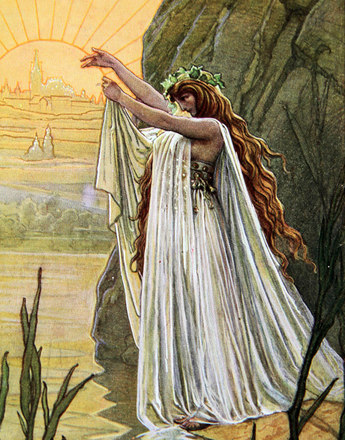"Two branches of one nation" – Czechoslovakism as a political programme
The definition of the Czechoslav nation usual in the Habsburg empire covered the speakers of Slavic dialects in Bohemia, Moravia and Upper Hungary. These were regarded as a single entity, as was also apparent in the official lists of linguistic circumstances, where Czech and Slovak were mostly recorded together.
Czechs and Slovaks are two linguistically very closely related Slav peoples in central Europe. At the time of the national renaissance, the similarity of the languages suggested an original ethnic unity that had pursued different directions over the course of history. The Slavs of Bohemia and Moravia had fallen under German influence, while the area settled by the Slovaks fell under Magyar rule as an integral part of Hungary.
Differently strong national identities developed in the three regions. Bohemia was the centre of Czech nation-forming, and the Bohemian version of Czech became the standard for the modern written language. The Moravian versions of Czech were given the status of dialects. While the Moravian Czechs allowed themselves to be included in the Bohemian-Czech nation-forming process – not least due to the to their constitutionally equal position, since both lands were part of the Austrian hereditary lands – the Slovaks followed a path of their own.
Unlike the Czechs, the Slovaks did not develop a written language in the late Middle Ages and the early Modern period. The mostly Protestant intelligentsia had therefore to use 16th century Czech translations of the Bible as the language of the church. This Slovakicised "Bible Czech" then also served the Slovaks as a written language in the absence of a codified standard Slovak. For this reason, a certain cultural proximity to Czech developed, although the spoken versions of Slovak in the 19th century were already far removed from the modern written Czech developing at the time.
Around 1800, when the concept of the modern Czech nation was being developed, the Slovaks, from the Prague point of view, were regarded as a part of the "Czechoslav" nation. There was the theory of the two branches of one nation. The ideal of unity, which in the early period of nation-forming was strongly embedded in both peoples, was however later shaken by the different problems arising in the emancipation process.
After 1848, the main accent of the Czech political programme was on resisting Greater-German tendencies and securing national autonomy within the empire. The Slovak national movement, for its part, focused its activities entirely on resisting the Hungarian government's Magyarisation policy.
An independent awareness amongst the Slovaks was only articulated around the middle of the 19th century, after Ľudovít Štúr (1815–1856) had developed a genuine Slovak written language on the basis of central Slovak dialects. This was followed by an emancipation of the Slovaks from the cultural hegemony claimed by the Czechs. The awareness of a common Czechoslovak nation was admittedly never abandoned entirely, but increasingly lost political significance.
The most important programmatic document of Czechoslovakism was The New Europe written in 1918 by Tomáš G Masaryk, which, under the influence of US President Wilson's doctrine of self-determination of the people's, proposed a democratic Czechoslovakia as the future home of the Czechs and Slovaks.
The implementation of this project came almost by surprise and, from the point of the Slovaks, was imposed by external circumstances. The Slovak point of view was only included at a late stage when finally, in the Pittsburgh Manifesto of the summer of 1918, the autonomy of Slovakia within the new Republic was guaranteed.
The young Czechoslovak Republic faced huge problems in the implementation of this principle. Huge differences were encountered, in terms of both cultural and social development. The Czechs were greater in number and economically further developed, and saw themselves as "national development aid workers" in Slovakia. The Slovaks for their part saw themselves controlled by the Czech "big brother". The extent of the federalism between Czechs and Slovaks remained a basic issue in the development of Czechoslovakia. Czechoslovakism was finally and definitively abandoned with the separation of the two nations in 1992.
Translation: David Wright
Hoensch, Jörg K.: Geschichte Böhmens. Von der slavischen Landnahme bis ins 20. Jahrhundert, München 1987
Kořalka, Jiří: Tschechen im Habsburgerreich und in Europa 1815 bis 1914. Sozialgeschichtliche Zusammenhänge der neuzeitlichen Nationsbildung und der Nationalitätenfrage in den böhmischen Ländern (Schriftenreihe des Österreichischen Ost- und Südosteuropa-Instituts 18), Wien 1991
Křen, Jan: Dvě století střední Evropy [Zwei Jahrhunderte Mitteleuropas], Praha 2005
Moritsch, Andreas (Hrsg.): Der Austroslavismus. Ein verfrühtes Konzept zur politischen Neugestaltung Mitteleuropas [Schriftenreihe des Internationalen Zentrums für Europäische Nationalismus- und Minderheitenforschung 1], Wien 1996
-
Chapters
- The drive for unification
- The radical German nationalists and their attitude to the Habsburg Monarchy
- The concept of ‘German Central Europe’
- Together we are strong: Pan-slavism and "Slavdom"
- The rise and fall of Austro-Slavism
- "Two branches of one nation" – Czechoslovakism as a political programme
- Viva l’Italia! Italian irredentism and the Habsburg Monarchy
- From Illyrism to Yugoslavism: competing concepts for a southern Slav nation
- Élyen a Magyar – long live the Magyars! Hungarian Magyarization policy





